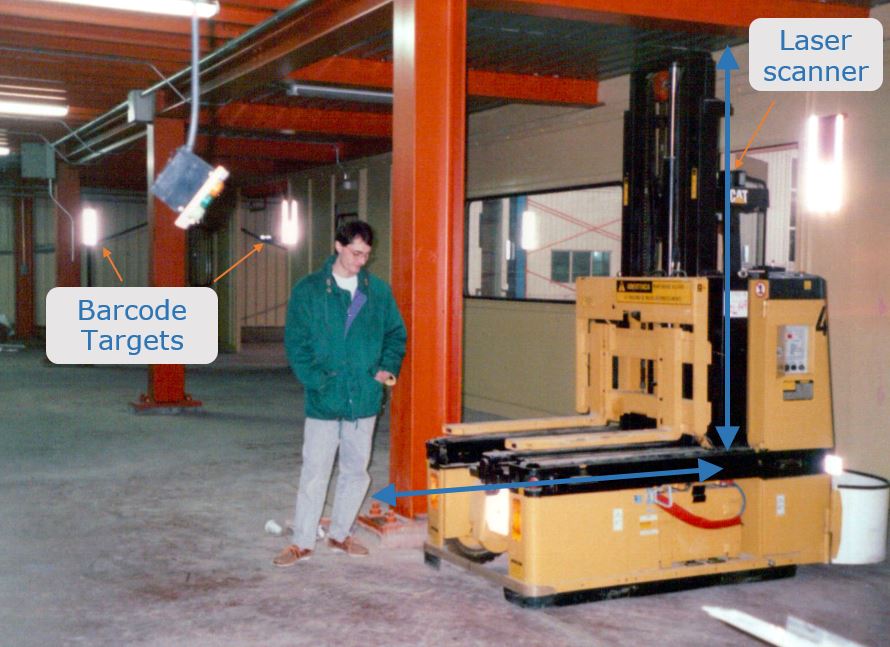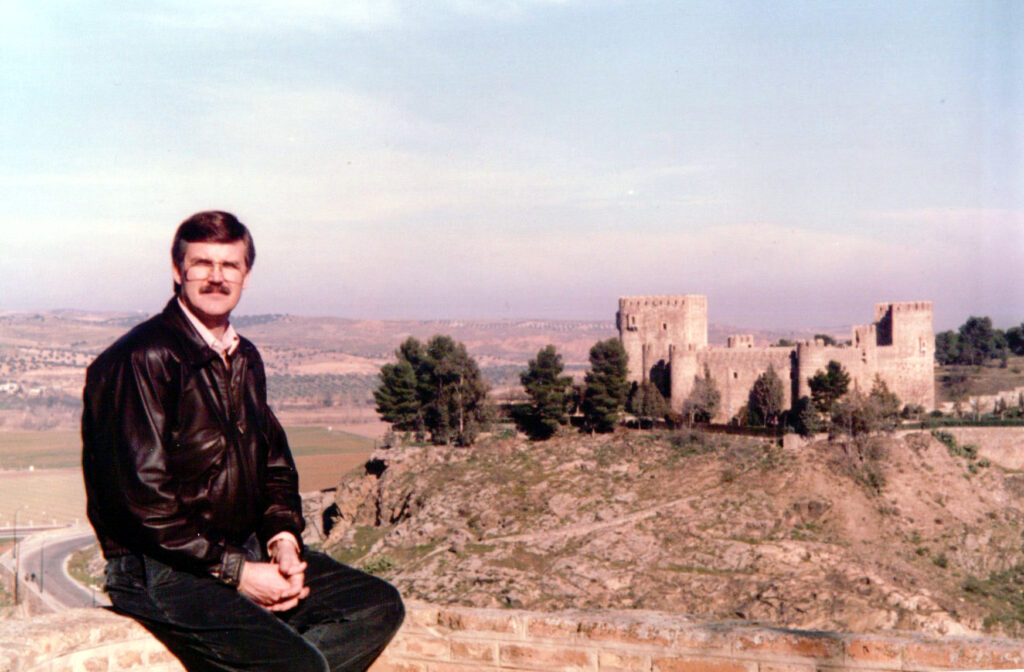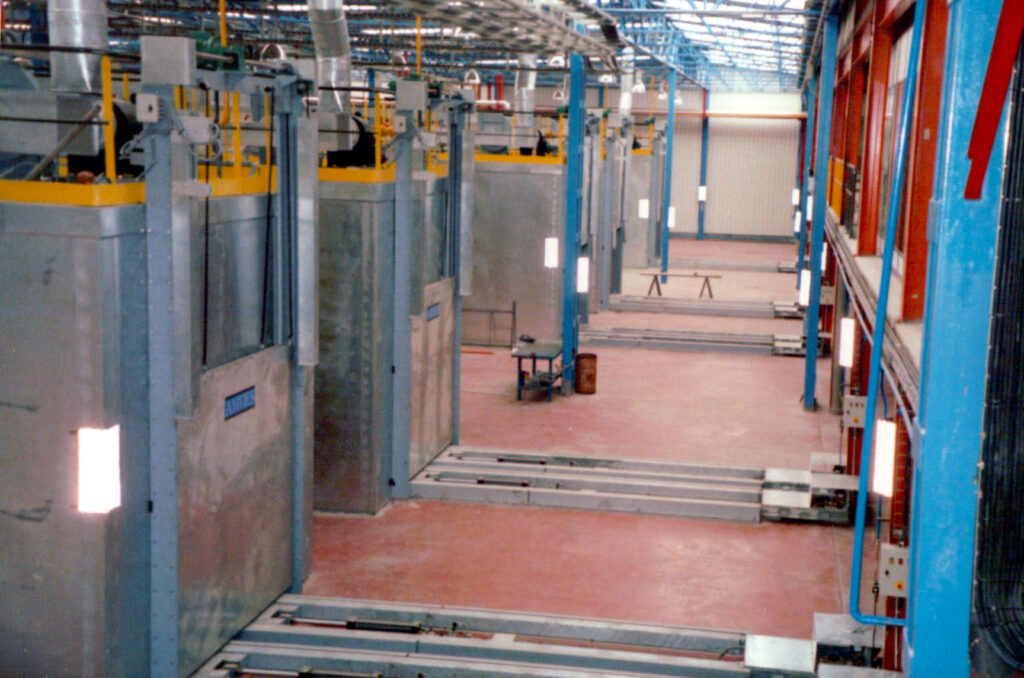 Vincent was a new engineer hired into our Paris office. To get some field experience, he was sent down to Madrid to work with me on the Vetrotex project.
Vincent was a new engineer hired into our Paris office. To get some field experience, he was sent down to Madrid to work with me on the Vetrotex project.
To provide some context, this is the Caterpillar Self Guided Vehicle (SGV). Barcoded targets were mounted around the factory, and surveyed so the exact location of each target was known. A rotating laser on the SGV reads the barcodes, and from the their locations, can triangulate the SGV’s location. A computer would send way-points to the SGV to route it. The SGV route could be easily changed to send it anywhere in the operating envelope. The “SGV” term was to differentiate our robot from the automated guided vehicles (AGV) available from other companies. An AGV follows a fixed route such as a line painted on the floor or wire embedded in the concrete.

The Vetrotex plant needed a forklift style vehicle. The mast can traverse to the back of the vehicle to allow the forks to travel from ground level to a height of 10 feet.

The French get a reputation for being assholes. That isn’t fair. While traveling in Paris, there were several times when locals went out of their way to help us. Vincent could be an arse, but I found him to be hilarious in an insulting way.
The Vetrotex plant was under construction. Along with the skilled trades who were building the factory, a dozen other companies were installing their equipment. I had wired a control panel to use for testing our system. It was expedient and worked, but wasn’t pretty. Vincent, an engineer who was just a month out of college, looks at my control panel and says,
“So (puff on the cigarette), you are proud of that?”
Hey, fuck you Vincent. The only help I have is that filthy prick, Arnold, and that means I’ve got no help at all.

Arnold was the project manager, with his only qualifications being that he spoke Spanish and was tall. I had successfully managed three projects while Arnold had been training lift truck mechanics.
I found Vincent’s comment to be hilarious in the arrogant, brass-balled sort of way. That kind of insult doesn’t bother me because I know who I am, and Vincent is just the new guy.
On Vincent’s first day, it was time for lunch, so I asked him a normal question about lunch preference. The factory was under construction, so we were going off-site. We had three hours for lunch, so plenty of time. A Spaniard would go to something like a diner for a fixed price, three-course lunch. Soup, which might have fish heads in it, an entree, and a dessert which is probably flan. I’m not a big fan of Spanish cuisine.
Gazpacho is almost always good. Lamb chops were a tasty option if they were on the menu. Paella is great, but that’s a call ahead dish for groups. All the good Spanish food is at nice restaurants.
Everywhere I’ve been in the world has Chinese restaurants, and they all look and work the same way. Except for Hong Kong, that’s different. So, for a workday lunch in Spain, I liked Chinese.
“Vincent, do you like Chinese food?”
“I don’t know if I’ve learned to appreciate Chinese food as much as some people seem to have.”
“So . . . would you like to go to the Chinese restaurant and I will explain some stuff to you?”
You get it. An America would ask say it was fine or ask about other options.
I liked working with Vincent, but it’s hard to tell if he liked working with me. That could just be a Vincent thing, but it seemed more cultural. Americans are mostly friendly. Northern Europeans are more guarded.
I asked Vincent why the French hate the British.
“It’s not us, we like everyone, but it’s the English, they hate us. Who can say why?”
A new English engineer was also sent to work with me for a while. Gary wasn’t as funny as Vincent.
Spanish money was the Peseta. The first time, Gary pronounced it like potat-a. I get it, a little British word play. He did that every time for two weeks.
I asked Gary why English people hate the French.
“No, we don’t hate the French, but they hate us for some reason.”
So, that’s the French and the English. A little about the Spanish skilled trades.
When I arrived in Spain, the envelope of the factory building was mostly complete. Some walls were still open to get equipment in. It was a construction site. Spain didn’t seem to have anything equivalent to OSHA.
Welders were still working on parts of the structure. Electrical lines, 440 V, were passed through puddles on the floor. The vending machine sold beer. For the equivalent of 50 cents, you could have a Hudepohl beer while you worked. The iron workers would send one guy to the machine, and he’d come back with six beers stacked up. I assume that was for the group. Don’t know for sure.
Here’s what the plant looked like many months later. Those metal boxes on the left are long ovens. A rack is placed on a conveyor, the door opens, the rack moves through, then a door opens, and the rack comes out. This is the exit side of the ovens.

The ovens are arranged in pairs, with two ovens about 10 feet apart. During installation, gas and electric had to be installed to the ovens. A pipe fitter had to go from the top of one oven, to the top of the adjacent oven.
At an American plant, the pipe fitter would go down the ladder, walk over and go up the ladder. In Spain, the pipe fitter stood on a blower, grabbed the roof truss, monkey walked over to the adjacent oven, and dropped on to a blower.
It sure was fun working in Spain.